Aesthetic Movement – The Style of the Victorian Aesthetic
What is an Aesthetic movement? What is Aestheticism? And what does the art of the Aesthetic movement look like? In this article, we will traverse through the art movement known as the Aesthetic movement of the late 19th century that aimed to separate itself from the growing visuals imposed by the Industrialization of Britain. We will also take a look at some of the most famous Aesthetic art styles that emerged during this period as well as a few famous Aesthetic artists.
The Aesthetic Movement
The Aesthetic movement is an art movement that emerged in Industrial Britain around 1860 and was considered a revolt against the materialistic culture brought about by the Industrial era. Simply put, the Aesthetic movement was driven by the desire for producing art for art’s sake – a phrase you may hear often in the debate surrounding what constitutes “good art”. Art for art’s sake implies that artists produce works merely for the aesthetic quality or value that the artwork evokes.
This means that in Victorian Britain, there was a growing desire for art that was simply appreciated for its surface value or beauty rather than deep concept, technical execution, subliminal qualities, symbols, or complex interpretations.
One of the major institutions associated with the Aesthetic movement is the Grosvenor Gallery, which opened its doors to Aesthetic artists in 1877 and provided an official platform for these artists to share their creative expressions of Aestheticism and voice their preferences as a rejection of academic art styles. The Grosvenor Gallery promoted the work and careers of many influential Aesthetic artists, including James Whistler, George Frederic Watts, Albert Moore, and Edward Burne-Jones.
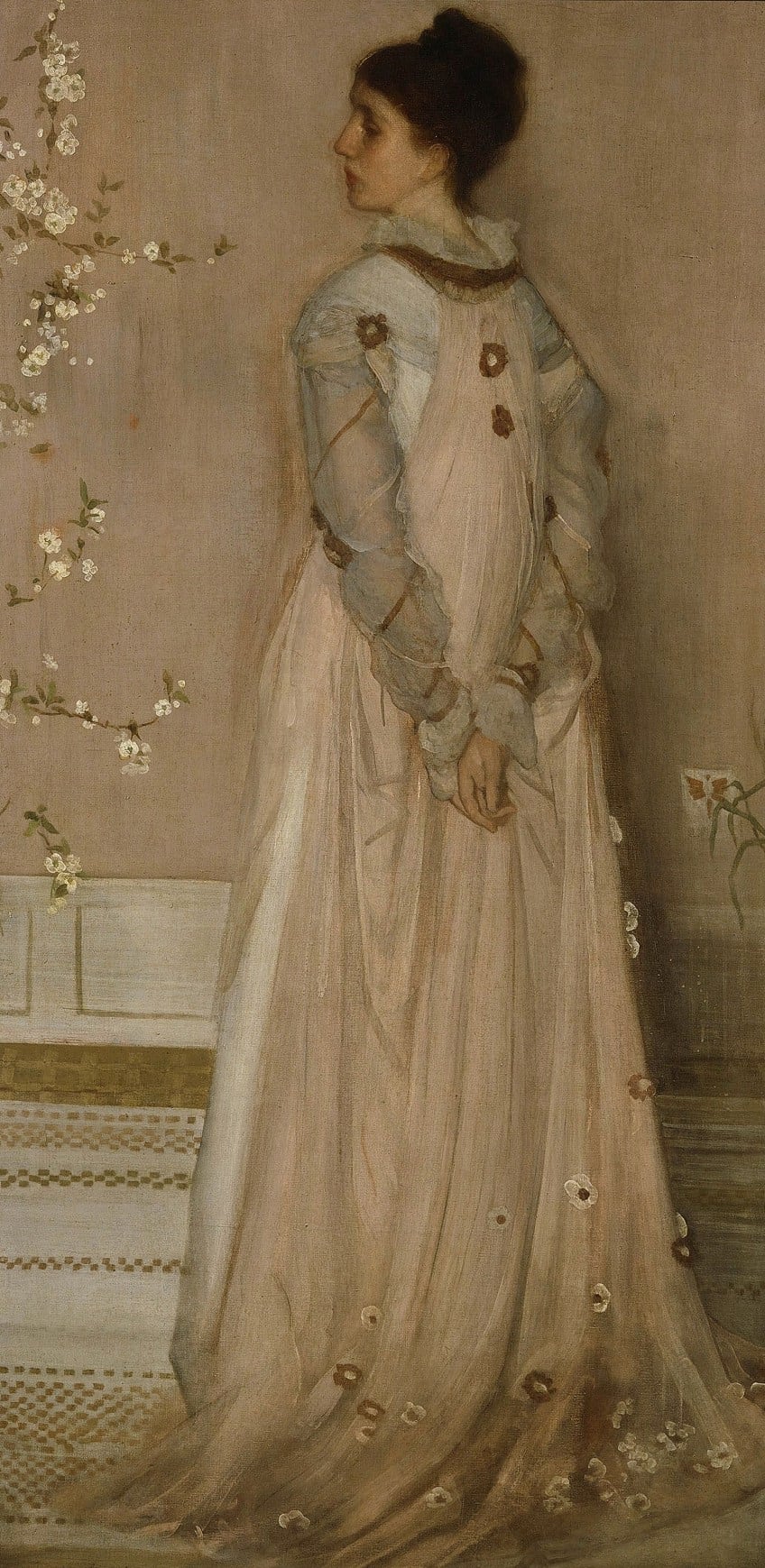
Not only was this institution responsible for hosting some of the movement’s most profound artists, but it was also the first gallery to pioneer electric lights as part of exhibition displays and paintings curated with sufficient space for viewing the artwork.
The exhibitions held here were meant to mimic a picture gallery as one would witness art in a home and this has since become a standard method of exhibition for many museums and galleries around the world.
The design of the Grosvenor Gallery also promoted the visual embellishments of the Aesthetic movement through Aesthetic elements in the design. This included the presence of green Genoan marble as well as green and yellow walls, which was mocked in a comedic play called Patience (1881) by Gilbert and Sullivan as “the greenery-yallery Grosvenor Gallery”.
The Power of Aestheticism
Between 1860 and the turn of the 20th century, the Aesthetic movement was responsible for creating vast change across the visual arts and design through modern concepts of the domestic environment and what that meant for the Victorian aesthetic. Aestheticism is credited with evoking not only the need for the acknowledgment of creating beautiful works of art for art’s sake but also for its reinvention of the relationships between society, art, ethics, and the decorative arts.
Many people tend to undermine the power of Aestheticism and the weight that the movement and its values have over society that extends beyond the 20th century and into Contemporary society.
The preference for leading one’s practice with Aestheticism in mind means that the artwork in question would be produced with the underlying message that the artwork’s purpose is solely for its beauty. While beauty and visual composition can be appreciated, it does bring up certain issues that draw one’s attention to the debate around whether artwork, regardless of its era of production, can be apolitical.
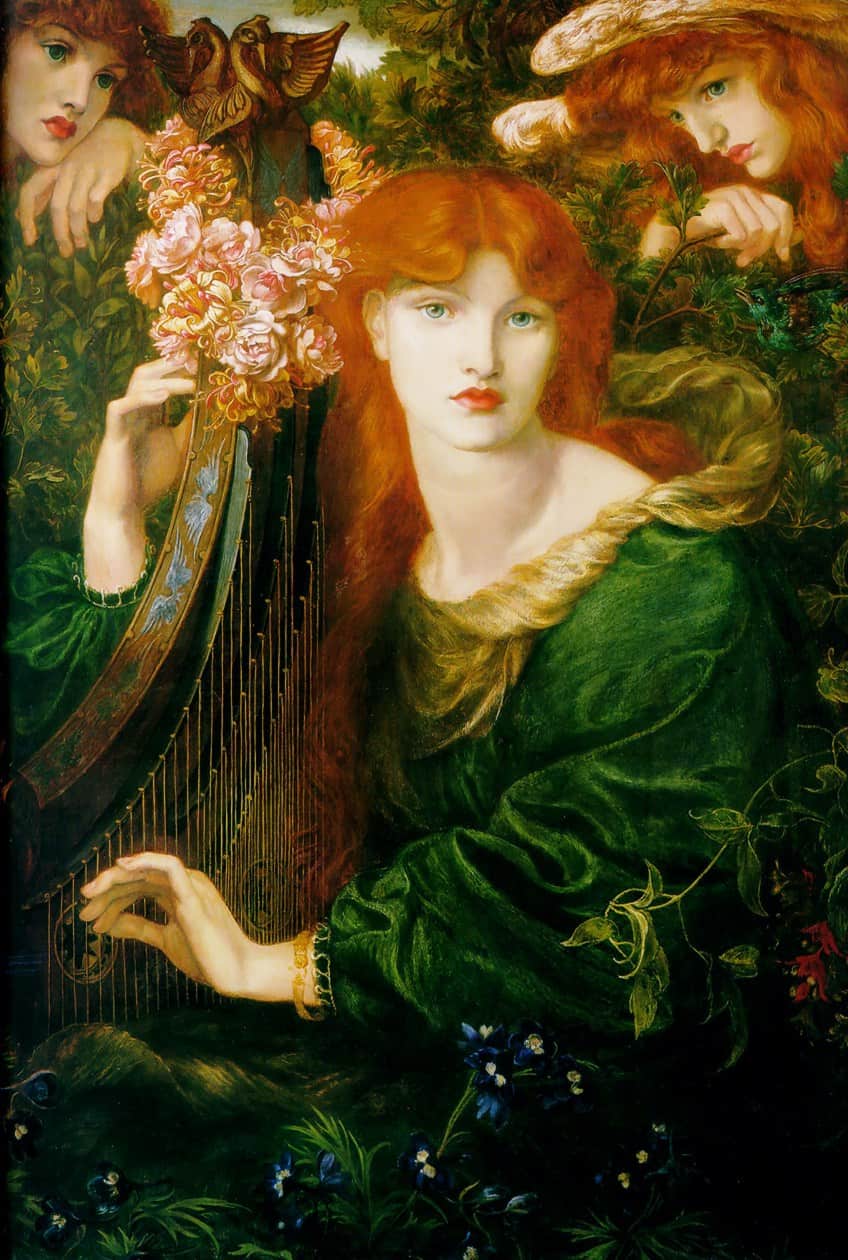
The main value behind Aestheticism is described as creating art that privileges aesthetic value over socio-political messages or affiliations. The underlying message is unpacked as art that is classified as part of the Aesthetic movement does not serve any allegorical, moral, or didactic function, instead, its only function is to subvert the traditional Victorian preference that art was inherently ethical in some way.
Viewing Aestheticism from this angle, can we then say that Aestheticism was, in fact, political as a movement? What do you think?
Popular Aesthetic Art Styles and Influences
The Aesthetic movement was influenced by the Avant-Garde movement and the literary influences of various French writers such as Stéphane Mallarmé and Paul Verlaine who were considered particularly dangerous influences. As you might imagine, an art movement that promoted amorality was criticized for its lack of value on morals.
The term aesthetic was first popularized by the Scottish essayist, Thomas Carlyle, whose many works of the 19th century advocated for Aestheticism and he was thereafter known as the apostle of Aestheticism.

One of the major influences of Aestheticism is German Romanticism, which had its roots across the visual arts, including philosophy, literature, and aesthetics. German Romanticism predated the Victorian Aesthetic movement and began around the late 18th century.
The basis of German Romanticism was founded on a preference for humor, wit, and beauty, which sounds quite similar to the English Aesthetic movement.
The German philosopher, Alexander Gottlieb Baumgarten, published a text in 1750 called Aesthetica, which shed light on the philosopher’s view on what was considered good and bad taste in beauty, which in turn sparked a debate on new definitions of what was aesthetic. Below, we will outline a few aesthetic art styles and trends that emerged during the Victorian Aesthetic movement.
Domestic Decoration: Japanese Influence
The Aesthetic movement in domestic society became somewhat of a trend among the public to shift to new approaches to design, especially in interior decoration and home embellishments. Japanese art styles and objects of Japanese origin took the Victorian household aesthetic by storm and with the re-establishment of foreign trade with Japan in 1853, England saw the importation of classical blue-and-white ceramics and home decor objects. The Japanese aesthetic was appealing to Victorian England since it provided their new trendy design lifestyle with elegant and ornate decorations that amplified the traditional Victorian home aesthetic and gave it an “exotic twist”.
The exotic twist was the style promoted in Japanese design and included asymmetrical shapes, flat patterns, simplified forms, and ornamental surface motifs.
Decorative Arts: Furniture, Utility, and Ornamentation
The late 19th century saw the establishment of specific design characteristics in the decorative arts, which included furniture and household objects that were crafted to serve both a utility function and an ornamental aesthetic function. An architect named Owen Jones published the primary principles of design called The Grammar of Ornament (1856), which outlined society’s need for a modern style that matched the growing modernization of the world and would move away from the traditional recycling of historical styles. Jones’ new approach rejected the styles of the past.
For household furniture, aesthetics was characterized by specific requirements, including influences from the Far East, fine china marked by blue and white motifs on porcelain, natural elements, and imagery that included peacocks, ginkgo leaves, feathers, and flowers, and ebonized wood (wood stained with a black finish) with gilded finishes.

In 1882, Irish poet Oscar Wilde traveled to Canada to deliver a lecture on “The House Beautiful” where he described the principles of Aestheticism as applied to design and the decorative arts. This was also recognized as the Ornamental Aesthetic style and involved preferred motifs such as floral designs, textures, and layered ceilings.
Fashion of the Aesthete
Aside from art, architecture, music, and even literature, Aestheticism has made its way into fashion since clothing is also closely tied to design, visual appeal, and beauty. Important to Aesthetic fashion was the pre-Raphaelite movement, which greatly informed the way that designers would approach their work.
The apparel and color palette used in pre-Raphaelite painting resonated with many artists and fashion designers alike and resulted in the transition from heavy fabric and prudish corsets to loose-fitting garments with detailed, ornate embroidery.
It was a move to a more Contemporary view of art and Aestheticism. For the male audience, the symbol and flair of the peacock was a famous motif that informed men’s fashion trends. This was brought to life as velvet jackets, dandy-looking apparel, and flowing ties.
Famous 1800s Aesthetic Artists and Artworks
An important predecessor to the Aesthetic movement was also the pre-Raphaelite art style of 1848, which presented itself as more of an escapism-driven art movement led by several men who shared a common interest in the rejection of mechanical modes of visual art-making practices. Below, we will look at some of the most famous 1800s Aesthetic artists and artworks that encompass aspects of the Victorian Aesthetic movement.
Symphony in White, No. 2: The Little White Girl (1864) by James Abbott McNeil Whistler
| Artist Name | James Abbott McNeil Whistler (1834 – 1903) |
| Date | 1864 |
| Medium | Oil on canvas |
| Dimensions (cm) | Support: 76.5 x 51.1 and frame: 108.5 x 83 x 11.8 |
| Where It Is Housed | Tate Gallery, London, United Kingdom |
Symphony in White, No. 2: The Little White Girl depicts a young woman in a white dress staring at her reflection in a mirror. The woman is portrayed in a deeply reflective state, which highlights the dream-like atmosphere of the painting. Her image in the reflection appears sad as her gaze directs the viewer’s eye to the ring on her left hand. One can only assume that the woman is sad over her marriage.
Another interpretation of this reflective Victorian aesthetic is that Whistler may have also intended on referencing another painting by Diego Velázquez called Rokeby Venus (1647), which also illustrates a woman in deep contemplation of her reflection.
The projection of the female gaze onto itself with the allusive presence of the male gaze is what makes the composition interesting. The poet and playwright, Algernon Charles Swinburne was so inspired by the painting that he wrote Before the Mirror (1866) as an accompanying piece to the painting. Whistler was impressed by Swinburne’s inspired poem and had it printed on gold paper and framed.

The true model for the painting was, not surprisingly, Whistler’s mistress, Jo Hiffernan, at the home they frequented in Chelsea. Hiffernan is seen holding a Japanese fan, which was popular in the European market at the time. Whistler was one such artist who was heavily invested in Japanese culture, as was the trend of Victorian aesthetics at the time.
The entire painting contains Japanese-inspired themes that can be seen in the blue and white vase and the pink azaleas set against the neutral background.
The image is also divided by elements such as the mirror to add angles to the composition and recreate the aesthetic of a Japanese print. The title of the painting was adjusted from The Little White Girl to Symphony in White, No. 2 to draw attention to the arrangement of colors as opposed to the subject of the painting, which alludes to regret and despair.
Monna Vanna (1866) by Dante Gabriel Rossetti
| Artist Name | Dante Gabriel Rossetti (1828 – 1882) |
| Date | 1866 |
| Medium | Oil on canvas |
| Dimensions (cm) | 88.9 x 86.4 |
| Where It Is Housed | Tate Gallery, London, United Kingdom |
Alexa Wilding is at the forefront of this classic 1800s aesthetic painting that was the prime example of a focus on all things beauty and luxury. The painting. Monna Vanna was created by Dante Gabriel Rossetti in 1866 as part of a series of Victorian aesthetic paintings that focused on sensuality and beauty and featured different models.
The aesthetic of beauty that Rossetti promoted was auburn hair and a red coral necklace that were the final touches on this “summary of Victorian beauty”.
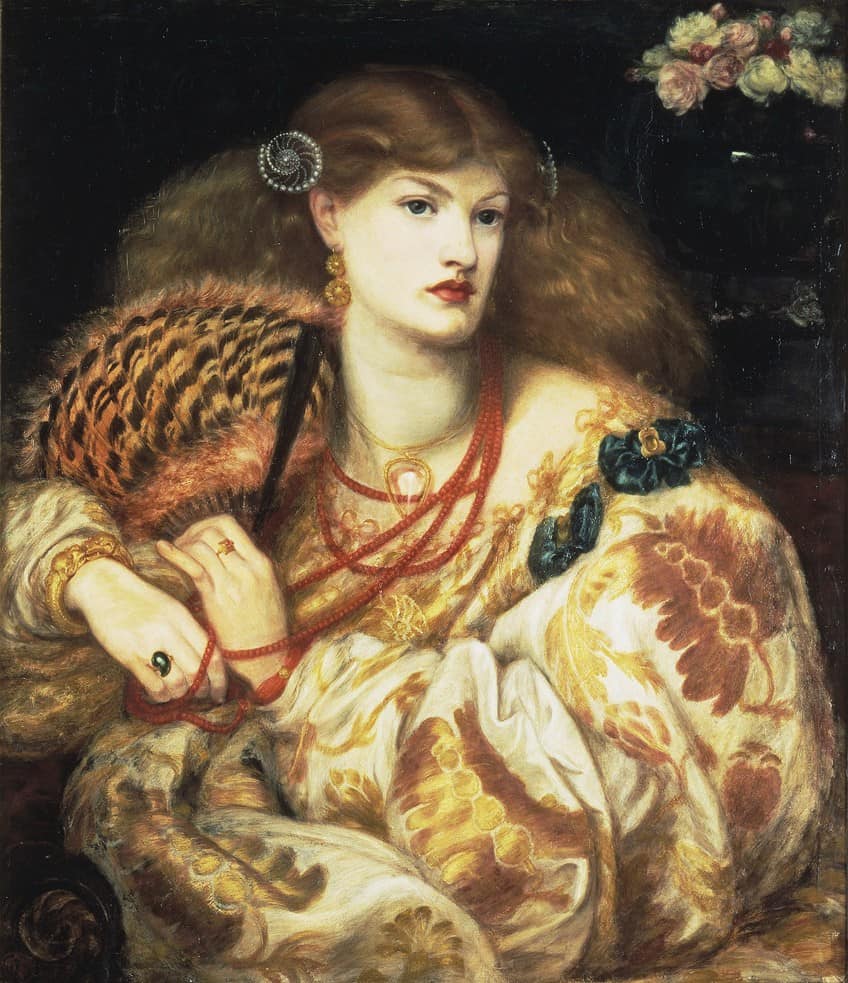
Other key elements of beauty and appreciation of opulence include the large sleeve on Wilding’s dress, the white and gold designs, heavy drapery, and decorative jewelry. The painting was initially called Venus Veneta to represent a beautiful Venetian woman in a white and gold dress.
The final title of the painting, Monna Vanna, refers to a vain woman and was created for pure aesthetic value with Rossetti himself claiming that it was one of his best works made specifically for decoration.
Charger (1882 – 1888) by William de Morgan
| Artist Name | William Frend de Morgan (1839 – 1917) |
| Date | 1888 |
| Medium | Glazed ceramic; lustered earthenware |
| Dimensions (cm) | 51.4 x 6.7 |
| Where It Is Housed | The Metropolitan Museum of Art, New York, United States |
William de Morgan is one of the most famous Victorian potters whose works convey the primary aesthetic styles and preferences of the Aesthetic movement. With an artistic background in stained glass painting under William Morris’ company, De Morgan began to experiment with earthenware and produced some of the most exquisite and detailed ceramics.
Charger is a series of glazed ceramic pieces inspired by Hispano-Moresque ware of the 15th century.
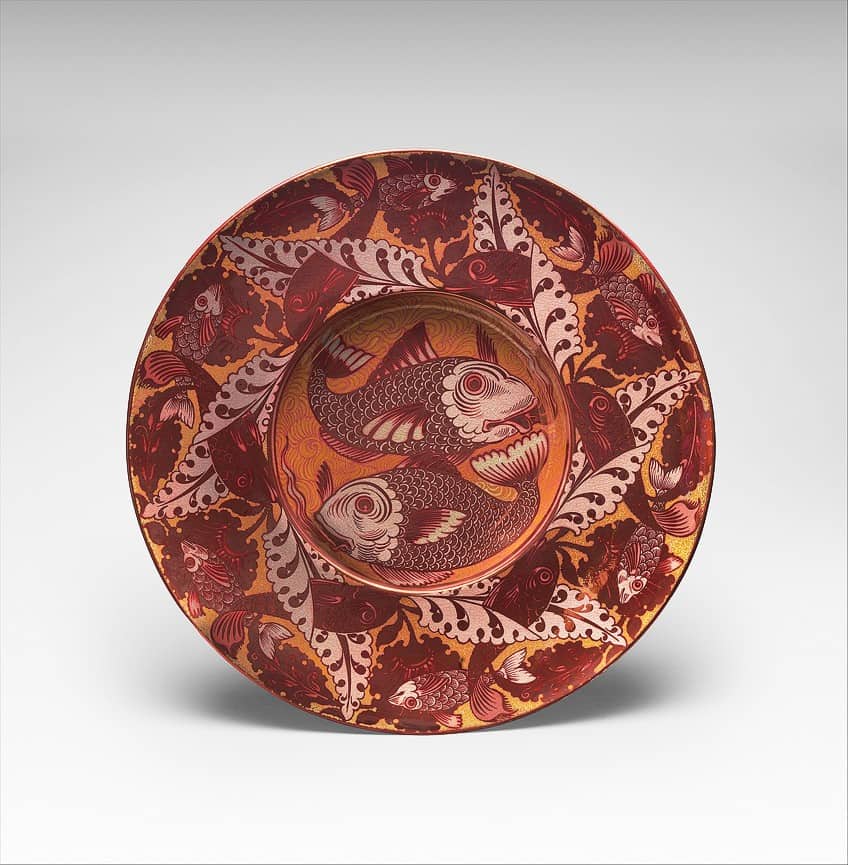
This piece is a combination of yellow and red lusters to portray fish in a leafy pond. The piece was initially owned by William Morris and was on display at his home in Hammersmith, London. Another stunning charger by De Morgan is a vivid blue, yellow, and green lustered ceramic with a peacock design housed at the Birmingham Museum.
The Bath of Psyche (1889 – 1890) by Frederic Leighton
| Artist Name | Lord Frederic Leighton |
| Date | 1889 – 1890 |
| Medium | Oil on canvas |
| Dimensions (cm) | 62.2 x 189.2 |
| Where It Is Housed | Tate Britain, London, United Kingdom |
The Bath of Psyche is one of the most famous Victorian aesthetic paintings created in 1890 by Lord Frederic Leighton. The painting is the epitome of classical beauty as commonly found in classical art and depicts the figure of Psyche from the ancient Greek narrative of Cupid and Psyche as well as the 300 BCE sculpture Venus Callipyge. Psyche is depicted as undressing in preparation for her bath, which is an intimate scene for a Victorian painting.
Psyche also appears to be intrigued by her own reflection in the water and this brings one back to the notion of reflection and vanity as seen in many Aesthetic-era artworks and the admiration of ideal beauty.

Lord Frederic Leighton is credited with resurrecting the image of the ideal female nude in Victorian Britain since it was banished from society due to the Victorian fixation on sexual morality and “what should and should not be drawn in art”. As you can imagine, for an artist to depict a nude female body so proudly, he would have received a lot of harsh criticism. Aside from simply painting a nude form, Leighton was also criticized for his style, that being, he sensually painted The Bath of Psyche portraying self-appreciation and vanity.
Many critics, most likely male, concluded that her form was too “real” and, therefore, it was a threat to ethical decency.
The Loves of the Winds and the Seasons (1893) by Albert Joseph Moore
| Artist Name | Albert Joseph Moore (1841 – 1893) |
| Date | 1893 |
| Medium | Oil on canvas |
| Dimensions (cm) | 180 x 214.5 |
| Where It Is Housed | Blackburn Museum and Art Gallery, Blackburn, United Kingdom |
The Loves of the Winds and the Seasons is an 1893 oil on canvas painting by Albert Joseph Moore who was a famous painter whose subject matter revolved around decadence and the female figure. Decadence and luxury were the prime motives behind the Aesthetic movement, especially when it concerned painting and design for art collectors and domestic designers.
The Loves of the Winds and the Seasons is just one famous Aesthetic painting out of many that illustrate Moore’s affinity toward the representation of beauty encapsulated by images of women relishing in luxurious surroundings.
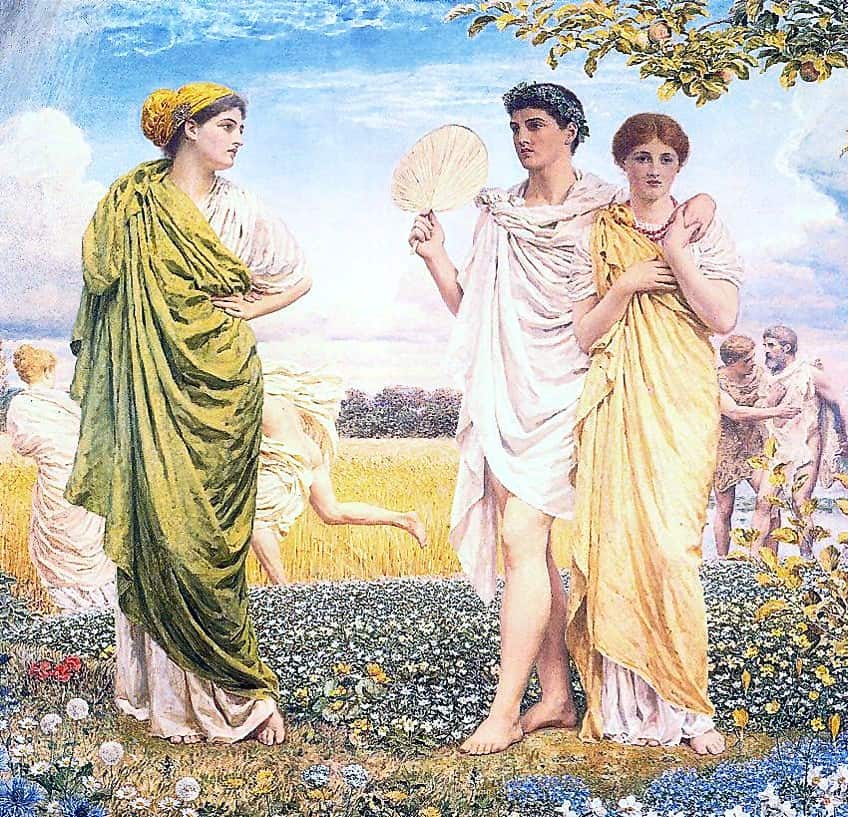
One might recognize this in modern-day terms as “the soft-girl life”. Moore often derived his titles after he completed his artworks and some of the delicate features that can be admired in his style are his depiction of drapery on garments that appear almost translucent and tissue-like, thus giving his figures a light and stress-free feeling.
The Attainment: The Vision of the Holy Grail to Sir Galahad, Sir Bors, and Sir Perceval (1895) by Sir Edward Burne-Jones, William Morris, and John Henry Dearle
| Artist Name(s) | Sir Edward Coley Burne-Jones (1833 – 1898); William Morris (1834 – 1896); and John Henry Dearle (1859 – 1932) |
| Date | 1895 |
| Medium | Wool, mohair, silk, and camel hair on cotton warp |
| Dimensions (cm) | 695 x 244 |
| Where It Is Housed | Birmingham Museum and Art Gallery, Birmingham, United Kingdom |
This large tapestry is a classic example of one of the Aesthetic movement styles that dominated the late 19th century. The tapestry was designed and created by Sir Edward Burne-Jones, William Morris, and John Henry Dearle, all of whom were influential Aesthetic artists of the 1800s. The Attainment: The Vision of the Holy Grail to Sir Galahad, Sir Bors, and Sir Perceval illustrate a scene from Le Morte D’Arthur, which was a 15th-century story about a spiritual journey for the Holy Grail led by King Arthur and his knights.
The Holy Grail was believed to be the cup that Jesus Christ used to drink from at the last supper. The tapestry presents the final scene portraying the three knights at a distance from the Holy Grail, which can be seen in a chapel.

The figure seen kneeling is Sir Galahad and near him are white lilies, which represent his purity. The figures on the left are Sir Bors and Sir Perceval. Symbols of Christ’s passion are seen with the three angels and the bleeding lance of Longinus, who was a Roman soldier that struck Christ on the cross. The presence of the Holy Spirit is also seen in the Pentecostal wind.
The artwork was originally crafted for exhibition in the dining room of William Knox D’Arcy, who was a prominent British magnate who is credited with founding the Persian oil and petrochemical industry.
Approximately several other woven textile artworks were created shortly after The Attainment: The Vision of the Holy Grail to Sir Galahad, Sir Bors, and Sir Perceval, with two other tapestries being commissioned by art collector Laurence Hodson.
Tea Gown (1897) by Liberty of London
| Artist Name | Liberty of London (est. 1884) |
| Date | 1897 |
| Medium | Silk and cotton brocade lined with taffeta with a silk-satin front panel |
| Dimensions (cm) | 151 (h) |
| Where It Is Housed | Victoria and Albert Museum, London, United Kingdom |
This golden tea gown was produced by a Victorian department store known as Liberty of London in 1897 and represents the pre-Raphaelite-inspired style that dominated fashion as part of the Victorian Aesthetic movement. The dress is equipped with large puffy sleeves in a medieval cut, which was characteristically quite loose and flowy. These loose garments appeared in many pre-Raphaelite paintings, which fueled the Aesthetic movement and the development of visual appeal according to Victorian fashion trends.
The establishment of the pre-Raphaelite tea gown by the Liberty of London department store was the first institution that catered to the shifting style of the Aesthetic era and its followers.
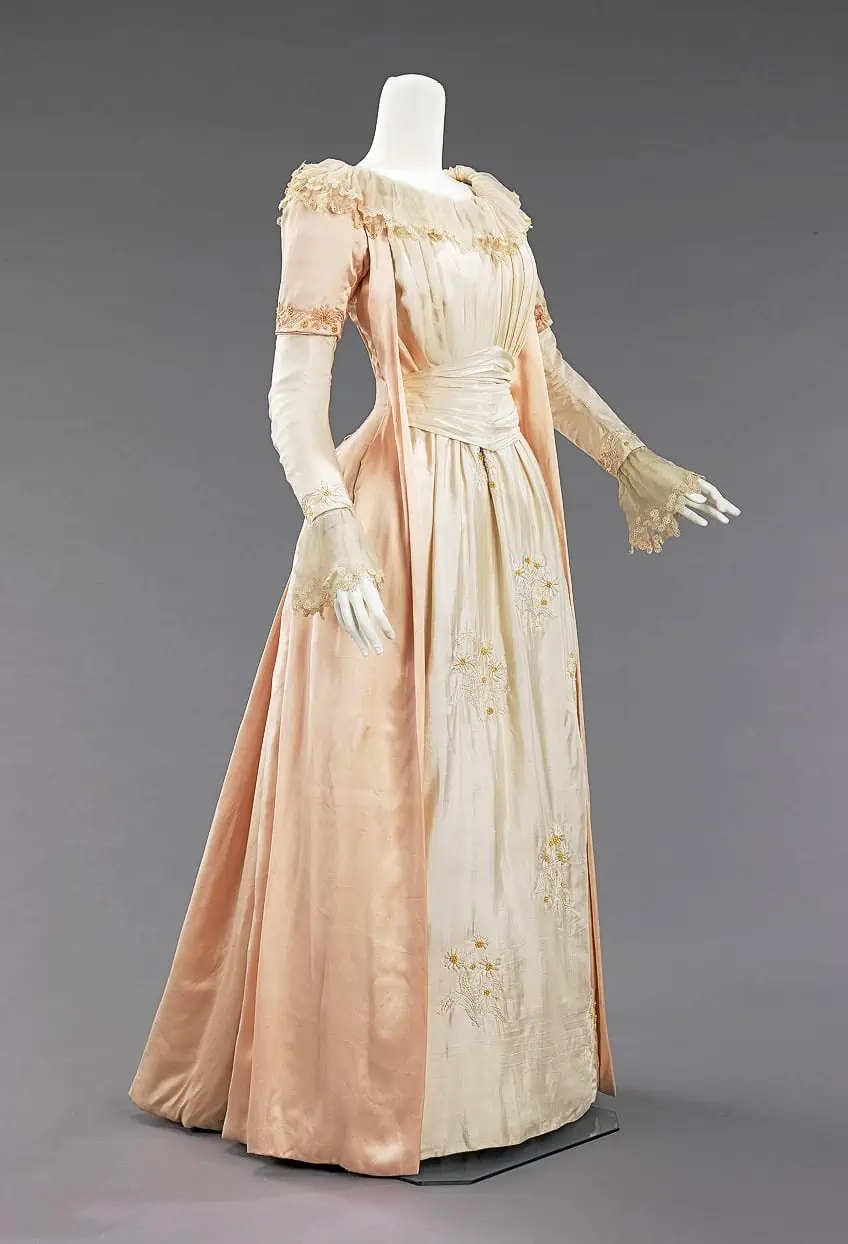
The dress contains brown and gold tones against a loose silhouette, which complimented the artistic vision of the Aesthetic movement. The loose garment was also seen as a healthier fashion statement in comparison to the restricting corsets commonly seen in Victorian apparel. The dress is also embellished with pomegranate and flower motifs, which were also popular designs from the Aesthetic movement. The tea gown is an example of how fashion leveraged previous art trends to form new aesthetic styles in Victorian England.
The Victorian Aesthetic art movement left a significant mark on the way that art was perceived in the 1800s and how art could be used as inspiration for other disciplines such as fashion, design, and architecture. The Aesthetic movement was a cultural shift in aesthetic preferences for the apolitical, the ornate, the exotic, and the Contemporary freedom of expression summarized as art for art’s sake. It is an interesting movement that poses many questions such as: can art truly be appreciated for aesthetic value while ignoring the political or social context of a time? What were the shortfalls of the Aesthetic movement? And does Aesthetic art hold the same value as that of conceptually-motivated artwork?
Frequently Asked Questions
What Is an Aesthetic Movement?
The Aesthetic movement is a Victorian movement that revolved around the idea of creating art for beauty and art for art’s sake instead of classical subject matter or heavily-loaded conceptual themes. The Aesthetic movement in England occurred during the Victorian age around the mid-19th century.
Who Are the Most Famous Aesthetic Painters?
The most famous Aesthetic painters are considered to be James Abbott McNeil Whistler, Edward Burne-Jones, Albert Joseph Moore, Lord Frederic Leighton, and Dante Gabriel Rossetti.
Why Was the Aesthetic Movement Significant?
The Aesthetic movement was significant because it is associated with a vast expansion of the appreciation for art and design across Victorian society, which posed further questions on the value of the artwork in connection with its purpose or underlying theme. Since art from this movement was produced to avoid the traditional academic standards of art, style, design, and fashion, the movement can be considered significant in expanding the preference for beauty in art simply for aesthetic value. The Aesthetic movement also marked the use of electric lighting in exhibitions and spaced-out displays of artwork for proper observation.
Jordan Anthony is a Cape Town-based film photographer, curator, and arts writer. She holds a Bachelor of Art in Fine Arts from the University of the Witwatersrand, Johannesburg, where she explored themes like healing, identity, dreams, and intuitive creation in her Contemporary art practice. Jordan has collaborated with various local art institutions, including the KZNSA Gallery in Durban, the Turbine Art Fair, and the Wits Art Museum. Her photography focuses on abstract color manipulations, portraiture, candid shots, and urban landscapes. She’s intrigued by philosophy, memory, and esotericism, drawing inspiration from Surrealism, Fluxus, and ancient civilizations, as well as childhood influences and found objects. Jordan is working for artfilemagazine since 2022 and writes blog posts about art history and photography.
Learn more about Jordan Anthony and about us.
Cite this Article
Jordan, Anthony, “Aesthetic Movement – The Style of the Victorian Aesthetic.” artfilemagazine – Your Online Art Source. January 18, 2023. URL: https://artfilemagazine.com/aesthetic-movement/
Anthony, J. (2023, 18 January). Aesthetic Movement – The Style of the Victorian Aesthetic. artfilemagazine – Your Online Art Source. https://artfilemagazine.com/aesthetic-movement/
Anthony, Jordan. “Aesthetic Movement – The Style of the Victorian Aesthetic.” artfilemagazine – Your Online Art Source, January 18, 2023. https://artfilemagazine.com/aesthetic-movement/.



